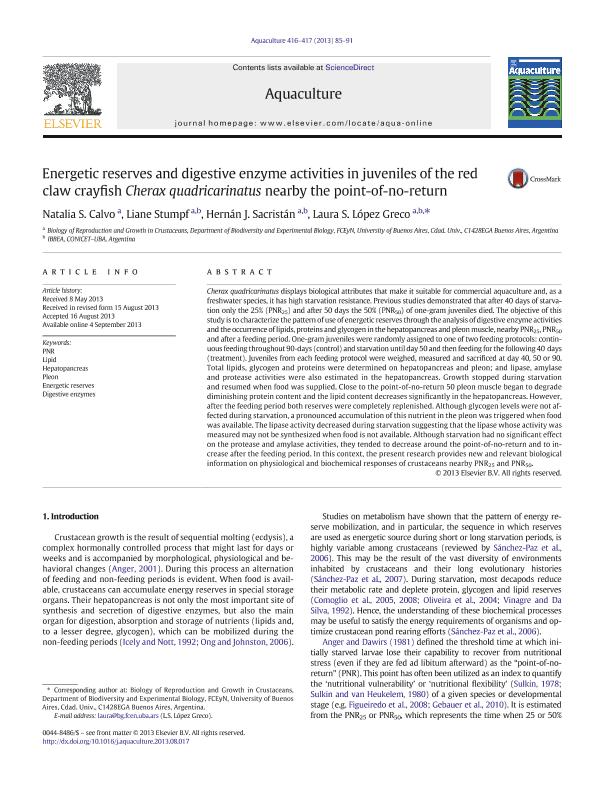Artículo
Energetic reserves and digestive enzyme activities in juveniles of the red claw crayfish Cherax quadricarinatus nearby the point-of-no-return
Fecha de publicación:
08/2013
Editorial:
Elsevier Science
Revista:
Aquaculture
ISSN:
0044-8486
Idioma:
Inglés
Tipo de recurso:
Artículo publicado
Clasificación temática:
Resumen
Cherax quadricarinatus displays biological attributes that make it suitable for commercial aquaculture and, as a freshwater species, it has high starvation resistance. Previous studies demonstrated that after 40 days of starvation only the 25% (PNR25) and after 50 days the 50% (PNR50) of one-gram juveniles died. The objective of this study is to characterize the pattern of use of energetic reserves, through the analysis of digestive enzyme activities and the occurrence of lipids, proteins and glycogen in the hepatopancreas and pleon muscle, nearby PNR25, PNR50 and after a feeding period. One-gram juveniles were randomly assigned to one of two feeding protocols: continuous feeding throughout 90-day (Control) and starvation until day 50 and then feeding for the following 40 days (Treatment). Juveniles from each feeding protocol were weighed, measured and sacrificed at day 40, 50 or 90. Total lipids, glycogen and proteins were determined on hepatopancreas and pleon; and lipase, amylase and protease activities were also estimated in the hepatopancreas. Growth stopped during starvation and resumed when food was supplied. Close to the point-of-no-return 50 pleon muscle began to degrade diminishing protein content and the lipid content decrease significantly in the hepatopancreas. However, after the feeding period both reserves were completely replenished. Although glycogen levels were not affected during starvation, a pronounced accumulation of this nutrient in the pleon was triggered when food was available. The lipase activity decreased during starvation suggesting that the lipase whose activity was measured may not be synthesized when food is not available. Although starvation had no a significant effect on the protease and amylase activities, they tended to decrease around the point-of-no-return and to increase after the feeding period. In this context, the present research provides new and relevant biological information on physiological and biochemical responses of crustaceans nearby PNR25 and PNR50.
Palabras clave:
Pnr
,
Lipid
,
Hepatopancreas
,
Pleon
,
Energetic Reserves
,
Digestive Enzymes
Archivos asociados
Licencia
Identificadores
Colecciones
Articulos(IBBEA)
Articulos de INSTITUTO DE BIODIVERSIDAD Y BIOLOGIA EXPERIMENTAL Y APLICADA
Articulos de INSTITUTO DE BIODIVERSIDAD Y BIOLOGIA EXPERIMENTAL Y APLICADA
Articulos(OCA CIUDAD UNIVERSITARIA)
Articulos de OFICINA DE COORDINACION ADMINISTRATIVA CIUDAD UNIVERSITARIA
Articulos de OFICINA DE COORDINACION ADMINISTRATIVA CIUDAD UNIVERSITARIA
Citación
Calvo, Natalia Soledad; Stumpf, Liane; Sacristán, Hernán Javier; Lopez, Laura Susana; Energetic reserves and digestive enzyme activities in juveniles of the red claw crayfish Cherax quadricarinatus nearby the point-of-no-return; Elsevier Science; Aquaculture; 416-417; 8-2013; 85-91
Compartir
Altmétricas




